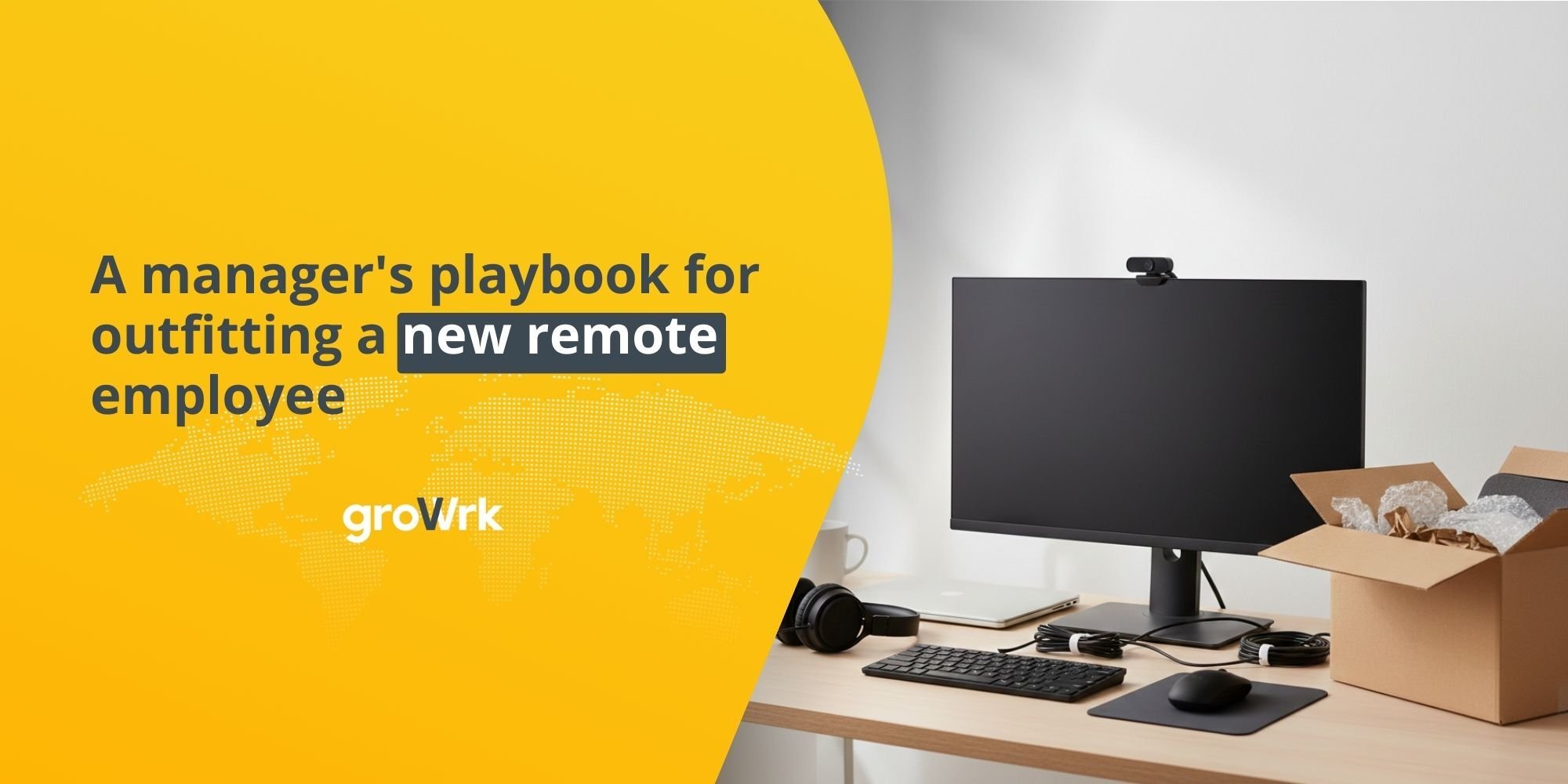How to Prevent Employe Burnout While Working on a Distributed Team
 GroWrk Team
GroWrk Team
It is no secret that burnout syndrome affects remote workers and distributed teams more than standard in-office employees. But how do you prevent employee burnout in these situations?
In a survey about work schedules we conducted with 379 remote workers, 39% reported working more than 40 hours per week.

In a survey conducted with 1500 hundred remote employees by Mental Health America (MHA) and Flexjobs in 2021, over 75% have experienced it at some point. 40% said they had experienced it specifically during the pandemic.
Many will be quick to throw remote work under the bus and say that it is the cause for all these burned-out employees. But most happy distributed teams will tell you that the key to their mental health is time management and a company that respects their boundaries.
Of course, identifying burnout and treating it is a much more complicated process than a content writer can tell you. So, to get to the bottom of how to prevent employee burnout on a distributed team, we teamed up with Managing Virtual Teams Psychologist and expert in systemic consulting organizations: Luis E Gonzales.

What is Employee Burnout?
Before we start talking about prevention, we first have to define burnout syndrome.
As Luis explains: “The first thing to keep in mind is that burnout is a syndrome that we should not confuse with common exhaustion. It is a more complex picture of prolonged work-related stress.”
In other words, burnout results from chronic workplace stress that isn’t managed correctly, eventually leading to a breaking point of extreme mental exhaustion.
It is like being incredibly tired, stressed, and unhappy at the same time while still having to fulfill your responsibilities. Almost as if you are sleep-walking through life. If employee burnout is left untreated, it can lead to severe health problems like high blood pressure or even cardiac arrest.
Why Employee Burnout is a problem
Burned-out employees cost an estimated $125 billion to $190 billion a year in healthcare spending in the U.S, but it is the companies these employees work for that absorb the immediate negative effects.
Decreased productivity, high employee turnover, and the loss of the best talent are all reasons employee burnout is bad for business.
You can’t place the blame on the employees either. As Luis states: “Contrary to what we might think, the causes of burnout are much more associated with factors inherent to the position and work environment than to individual factors or personality profiles.”
A Harvard study even found that excessive collaboration, weak time management disciplines, and a tendency to give the most talented too much work were the most common culprits for burnout employees across organizations.

So, as a manager of a distributed team, how do you avoid these trends? How do you approach identifying and treating burned-out employees?
This is where Luis steps in.
How to Recognize Employee Burnout? What are the symptoms of it?
“A complete diagnosis can only be conducted by a mental health professional. The Maslach Burnout Inventory (MBI) is often used to identify this.” says Luis.
So we asked how his team uses this inventory.
“The inventory says that burnout syndrome is characterized by a mix of exhaustion, cynicism, and ineffectiveness. If you are looking for signs in your team, we can be attentive to some symptoms of these components in ourselves or in the people of our team.”
Here is a useful checklist he shared with us:
Symptoms of exhaustion:
- Lack of motivation
- Irritability
- Fatigue
- Insomnia
- Memory issues
- Nervousness
- Headaches
- Irritability
- Change in appetite
- Trouble concentrating
- Depression
- Increased illness
- Loss of energy
Symptoms of cynicism and detachment
- Isolation
- Lack of enjoyment
- Apathy
- Impatience
- Being critical
- Feeling persecuted
- Hopelessness
- Negative attitude
- Excessive use of sarcasm
- Disillusionment with work
- Loss of job satisfaction
- Self-medication
- Dread of work
Symptoms of ineffectiveness
- Loss of productivity
- Poor performance
- Missing deadlines
- Habitual complaining
- Missing work goals
What Can Lead to Employee Burnout? What Is Contributing to Employee Burnout?
As Luis and the Harvard study mentioned before, the leading causes for burnout have more to do with the company culture than the individual.
But he also warns: “That does not mean that we should not attend to this dimension. In addition, there are some sociodemographic variables that are part of a multi-causal understanding of this syndrome.
In Managing Virtual Teams, from our experience with remote and hybrid teams, we recognized that the relatively recent and abrupt transition to work remotely generated several stressors that were moderate or even nonexistent in many companies before the pandemic.”

He gave us a handy list of the factors that lead to employee burnout here:
Individual factors
- High self-demand
- Low tolerance for failure
- Extreme perfectionism
- The constant need for control
- A feeling of being indispensable at work
- High ambition
- Excessive desire to stand out
- Difficulty recognizing and expressing emotions
- Impatience and competitiveness
- Excessive involvement with work
- Little personal life outside of work
- Idealism
- Sensitivity
Factors inherent to the position and work environment
- Shifts and work hours
- Job security and stability
- Antiquity: more frequent in the first two years in the company and after 10 years.
- Excessive or insufficient promotion experiences.
- Incorporation of new technologies: adaptation problems, fear of dismissal, feeling of being controlled, feeling of isolation from the team, among others.
- More common in highly centralized organizational structures, with many hierarchical levels, with a lot of bureaucracy, in positions of higher responsibility.
- Little possibility of control by the employee.
- Little or lack of feedback.
- Few negative or stressful interpersonal relationships.
- Poor renumeration.
- Business strategy: Not enough personnel, work overload, little or no investment in training and well-being.
Sociodemographic factors
- Age: more frequent at the beginning of working life
- Sex/gender: more frequent in women who combine workload with family responsibilities.
- Marital status: more frequent in single people and/or without children.
How Can Managers Help Prevent Burnout? How can Companies implement these tactics for all their workers?
Unfortunately, in Luis’ experience, companies usually act or invite third parties to intervene when it is already too late. That is why his company developed a system to prevent burnout before it begins to snowball across an organization.
“In Managing Virtual Teams, we work with a Promotion, Prevention, and Intervention model (PPI), and we have learned that there are some simple strategies that every company and work team can implement and promote daily:”
- Provide information about burnout syndrome, its symptoms, and its main consequences to be easier to detect it early.
- Monitor the conditions of the work environment, using evaluation processes to see and act upon needs and challenges in mental and emotional well-being.
- Promote teamwork and spaces suitable for interpersonal exchange.
- Design and implement workshops for CEOs and managers on leadership, social skills, and management development.
- Implement better onboarding programs and adjust the position for new staff.
- Anticipate changes, offering workshops to develop skills, knowledge, and strategies to deal with them.

How to Manage Employee Burnout? How much time does it take, on average, to return 100%?
So, of course, it is one thing preventing employee burnout, but it is a whole other cup of tea to manage and recover from it. A vacation on the beach is one way to decompress and disconnect, but it doesn’t address the root cause of burnout.
Here is what Luis had to say:
“Burnout syndrome affects many areas of life, and its causes are multiple, so it is not possible to have a specific time estimate to be able to speak of a full recovery. The important thing will always be that medical interventions consider these levels:
The Individual Level: contemplate the three fundamental spheres
1. Physiological, through techniques of physical relaxation, breath control, and biofeedback, among others
2. Behavioral, through training techniques in assertive behavior, social skills, problem-solving, and self-control
3. Cognitive, which aims to improve the perception, interpretation, and evaluation of work problems and personal resources that the individual performs daily.
The Group Level: The purpose here is to break the isolation and improve socialization processes.
It is essential to promote policies of cooperative work, integration of multidisciplinary teams, and group meetings.
You can even offer your team opportunities to work directly on their motivation and engagement to help protect them. In our experience with the Mapping optimism workshop, many remote teams had overcome several risk factors on an individual and organizational level.
The Organizational Level: Eliminate or reduce the stressors of the workplace
Companies should create more horizontal structures and focus on decentralization in decision-making. They should also provide greater independence and autonomy, fair internal promotions, flexible hours, and competitive salaries.

How to Fix Employee Burnout? What is your opinion on a 4-day workweek?
Some companies like Pictochart and countries like Spain have been running tests with a 4-day workweek. The results have been overwhelmingly positive in most cases, and there have even been productivity increases. We asked Luis if this could be the key to eliminating burnout.
“The reduction of the flexibility of working hours can undoubtedly contribute to improving a series of aspects related to burnout syndrome.
In principle, we could think that it offers more expansive spaces for rest, cultivating hobbies, and strengthening ties or interpersonal relationships outside of work.
Recently, we have worked with more frequency with hybrid teams. This experience has shown us that the flexibility and autonomy in terms of in-office and remote work and working hours positively impacted the employee’s mental health.
However, it would be best if you always considered that work shifts and hours might not be the only or most problematic factor for an employer. As we have seen so far, burnout is a complex condition, and its origin is multi-causal.
Therefore, there is no single key to beat burnout, and it is mostly a combination of actions. We strongly suggest:”
- Recognize burnout as a problem that affects the mental health of around 8% of employees.
- Raise awareness within the organization and provide information and material to identify it.
- Have promotion, prevention, and intervention plans for burnout, combining actions to build healthier work environments and a better work-life balance.
- Bet on comprehensive approaches that consider the complexity of this syndrome and its multi-causality.
- Invest time and resources in the mental and emotional well-being of employees and the prevention of occupational risks.
Wrapping Up
As more companies go remote or more people pursue entrepreneurship, burnout will increasingly become more prevalent. Not to mention with the new Delta variant circling around and further pandemics or disasters on the horizon, the world is becoming increasingly more stressful.
Another solution that is gaining popularity from organizations like Bumble and Smart Recruiters is to give their workers full weeks off or a mental health day just for burnout. A whole week basically to disconnect and recharge. Those have also seemed effective in alleviating the burden of burnout and increasing employee well-being.
Companies need to be conscious of their leave policies and include burnout as a reason to take a sick day. As managers, it is also important not to encourage a workplace culture of overworking and always have an open dialogue about mental health with your teams. Solving burnout is not an individual problem but one that affects the entire organization.






